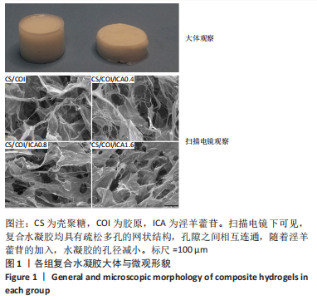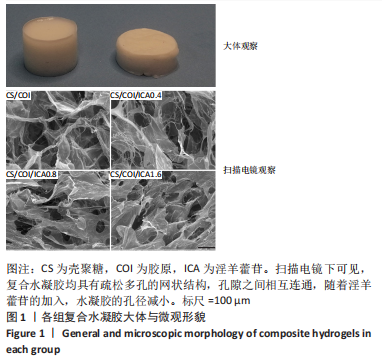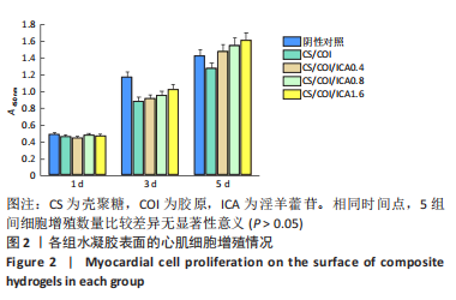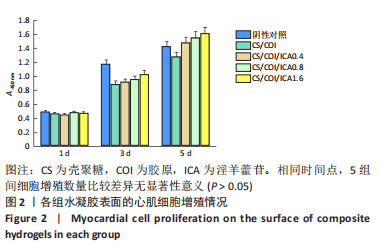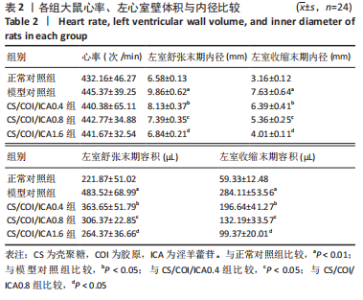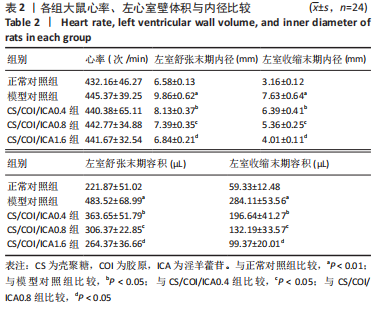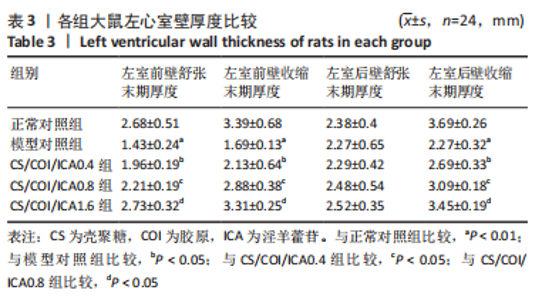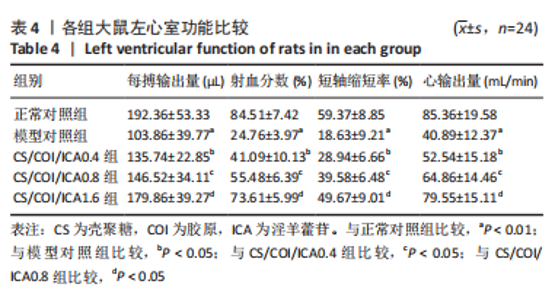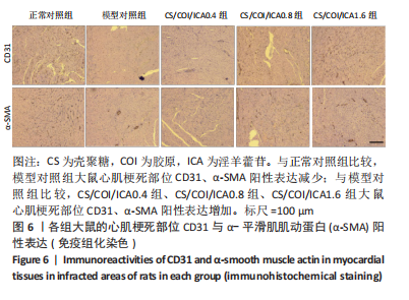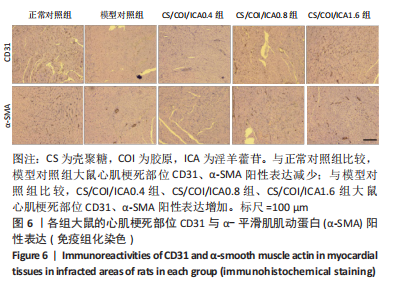Chinese Journal of Tissue Engineering Research ›› 2023, Vol. 27 ›› Issue (25): 3992-3998.doi: 10.12307/2023.550
Previous Articles Next Articles
Effects of icariin combined with injectable chitosan/collagen composite hydrogel on angiogenesis in rats with myocardial infarction
He Wenfeng, Xue Cheng, Zheng Jiankang, Shuai Zhuang, Yue Rongchuan
- Department of Cardiology, Affiliated Hospital of North Sichuan Medical University, Cardiovascular Disease Laboratory, Nanchong 637000, Sichuan Province, China
-
Received:2022-08-15Accepted:2022-09-26Online:2023-09-08Published:2023-01-17 -
About author:He Wenfeng, Master, Attending physician, Department of Cardiology, Affiliated Hospital of North Sichuan Medical University, Cardiovascular Disease Laboratory, Nanchong 637000, Sichuan Province, China -
Supported by:The National Natural Science Foundation of China, No. 81600232 (to YRC); the Key Project of Medical Colleges, No. CBY18-A-ZD14 (to HWF)
CLC Number:
Cite this article
He Wenfeng, Xue Cheng, Zheng Jiankang, Shuai Zhuang, Yue Rongchuan. Effects of icariin combined with injectable chitosan/collagen composite hydrogel on angiogenesis in rats with myocardial infarction[J]. Chinese Journal of Tissue Engineering Research, 2023, 27(25): 3992-3998.
share this article
Add to citation manager EndNote|Reference Manager|ProCite|BibTeX|RefWorks
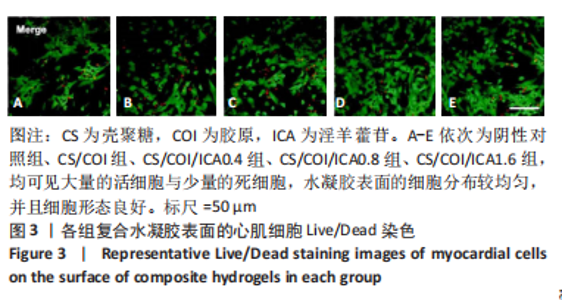
培养第5天Live/Dead染色后可见,5组均可见大量的活细胞与少量的死细胞,水凝胶表面的细胞分布较均匀,并且细胞形态良好(图3)。每个样本随机选择10个视野,统计其中的活细胞数量与死细胞数量,计算细胞存活率,得到阴性对照组、CS/COI组、CS/COI/ICA0.4、CS/COI/ICA0.8、CS/COI/ICA1.6组细胞存活率依次为(85.32±3.21)%,(84.04±4.67)%,(89.32±2.14)%,(91.37±1.37)%,(93.25±2.21)%,CS/COI/ICA0.4、CS/COI/ICA0.8、CS/COI/ICA1.6组细胞存活率高于阴性对照组、CS/COI组(P < 0.05)。"
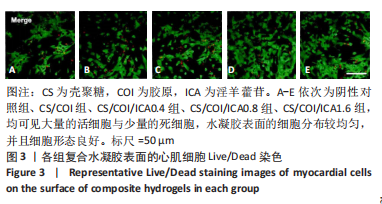
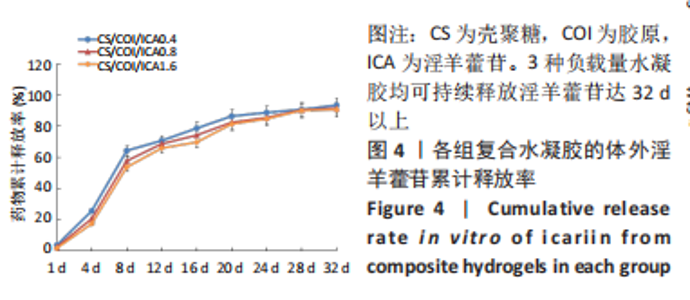
2.3 复合水凝胶的体外药物释放 由图4水凝胶药物体外释放曲线可见,3种水凝胶均可持续释放淫羊藿苷达32 d以上,水凝胶在前8 d之内快速大量释放淫羊藿苷,至第8天时,CS/COI/ICA0.4、CS/COI/ICA0.8、CS/COI/ICA1.6组淫羊藿苷累计释放率依次达到(63.97±4.27)%,(57.37±5.62)%,(53.37±5.29)%,此后水凝胶释放淫羊藿苷的速率减慢,20-32 d的淫羊藿苷释放率趋于稳定,至30 d时,CS/COI/ICA0.4、CS/COI/ICA0.8、CS/COI/ICA1.6组淫羊藿苷累计释放率依次达(93.09±1.19)%,(91.13±1.89)%,(90.37±2.07)%。"
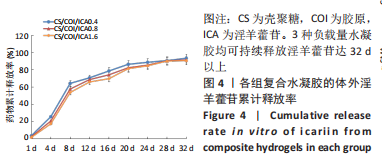
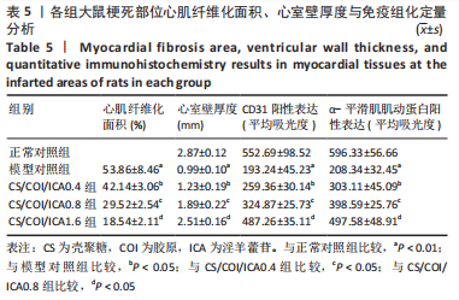
5组大鼠心率、左室后壁舒张末期厚度比较差异无显著性意义(P > 0.05)。与正常对照组比较,模型对照组大鼠的每搏输出量、射血分数、短轴缩短率、心输出量明显减少(P < 0.05),左室前壁收缩末期厚度、左室前壁舒张末期厚度、左室后壁收缩末期厚度减少(P < 0.05),左室收缩末期内径、左室舒张末期内径、左室收缩末期容积、左室舒张末期容积增加(P < 0.05)。与模型对照组比较,CS/COI/ICA0.4组、CS/COI/ICA0.8组、CS/COI/ICA1.6组大鼠的每搏输出量、射血分数、短轴缩短率、心输出量明显增加(P < 0.05),左室前壁收缩末期厚度、左室前壁舒张末期厚度、左室后壁收缩末期厚度增加(P < 0.05),左室收缩末期内径、左室舒张末期内径、左室收缩末期容积、左室舒张末期容积减少(P < 0.05)。与CS/COI/ICA0.4组、CS/COI/ICA0.8组比较,CS/COI/ICA1.6组大鼠的每搏输出量、射血分数、短轴缩短率、心输出量明显增加(P < 0.05),左室前壁收缩末期厚度、左室前壁舒张末期厚度、左室后壁收缩末期厚度增加(P < 0.05),左室收缩末期内径、左室舒张末期内径、左室收缩末期容积、左室舒张末期容积减少(P < 0.05)。 2.4.2 Masson三色染色 由图5可见,模型对照组梗死部位可见广泛的胶原沉积与严重的心室扩张,心室壁较薄;相较于模型对照组,CS/COI/ICA0.4组、CS/COI/ICA0.8组、CS/COI/ICA1.6组梗死部位胶原沉积减少、心室扩张减轻、心室壁增厚,其中以CS/COI/ICA1.6组改善最明显。 利用Image J软件定量分析心肌纤维化面积与左心室壁厚度,得出以下结果:CS/COI/ICA0.4组、CS/COI/ICA0.8组、CS/COI/ICA1.6组心肌纤维化面积少于模型对照组(P < 0.05),心室壁厚度大于模型对照组(P < 0.05);CS/COI/ICA0.8组心肌纤维化面积少于CS/COI/ICA0.4组(P < 0.05),心室壁厚度大于CS/COI/ICA0.4组(P < 0.05);CS/COI/ICA1.6组心肌纤维化面积少于CS/COI/ICA0.8组(P < 0.05),心室壁厚度大于CS/COI/ICA0.8组(P < 0.05),见表5。"
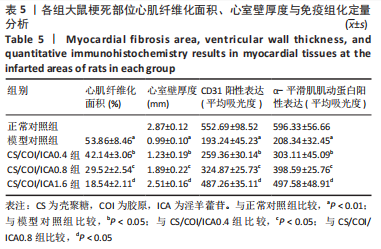
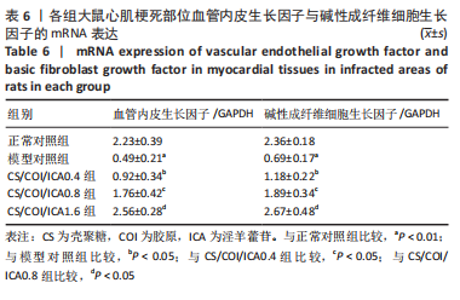
2.4.4 RT-PCR检测 5组大鼠心肌梗死部位血管内皮生长因子与碱性成纤维细胞生长因子的mRNA表达量,见表6,结果显示:模型对照组血管内皮生长因子与碱性成纤维细胞生长因子的mRNA表达量显著低于正常对照组(P < 0.05),CS/COI/ICA0.4组血管内皮生长因子与碱性成纤维细胞生长因子的mRNA表达量显著高于模型对照组(P < 0.05),CS/COI/ICA0.8组血管内皮生长因子与碱性成纤维细胞生长因子的mRNA表达量显著高于CS/COI/ICA0.4组(P < 0.05),CS/COI/ICA1.6组血管内皮生长因子与碱性成纤维细胞生长因子的mRNA表达量显著高于CS/COI/ICA0.8组(P < 0.05)。"
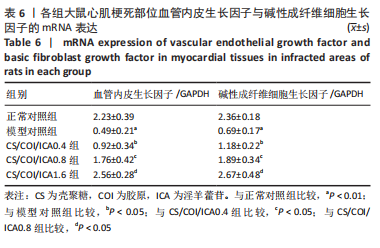
| [1] JIANG K, XU Y, WANG D, et al. Cardioprotective mechanism of SGLT2 inhibitor against myocardial infarction is through reduction of autosis. Protein Cell. 2022;13(5):336-359. [2] 鞠帆,袁昕,李宝童,等.心肌梗死后室间隔穿孔的手术时机探讨[J].中国循环杂志,2022,37(3):256-264. [3] SONG L, CHEN X, MI L, et al. Icariin-induced inhibition of SIRT6/NF-κB triggers redox mediated apoptosis and enhances anti-tumor immunity in triple-negative breast cancer.Cancer Sci. 2020;111(11):4242-4256. [4] LIU S, XU DS, LI M, et al. Icariin attenuates endothelial-mesenchymal transition via H19/miR-148b-3p/ELF5 in ox-LDL-stimulated HUVECs. Mol Ther Nucleic Acids. 2020;23:464-475. [5] XU Y, JIANG Y, JIA B, et al. Icariin stimulates osteogenesis and suppresses adipogenesis of human bone mesenchymal stem cells via miR-23a-mediated activation of the Wnt/β-catenin signaling pathway. Phytomedicine. 2021; 85:153485. [6] SAI X, LI Z, DENG G, et al. Immunomodulatory effects of icariin in a myocardial infarction mouse model. Bioengineered. 2022;13(5):12504-12515. [7] LIU XJ, LV YF, CUI WZ, et al. Icariin inhibits hypoxia/reoxygenation-induced ferroptosis of cardiomyocytes via regulation of the Nrf2/HO-1 signaling pathway. FEBS Open Bio. 2021;11(11):2966-2976. [8] 陈思宇,李燕楠,颉丽英,等.负载碱性成纤维细胞生长因子温敏性壳聚糖-胶原复合水凝胶可减缓小鼠心肌梗死后心室的重构[J].中国组织工程研究,2021,25(16):2472-2478. [9] 商青青,周建业.透明质酸水凝胶包裹骨髓间充质干细胞改善心肌梗死大鼠的心功能(Ⅱ)[J].中国组织工程研究,2020,24(34):5559-5563. [10] EL-SHITANY NA, EID BG. Icariin modulates carrageenan-induced acute inflammation through HO-1/Nrf2 and NF-kB signaling pathways. Biomed Pharmacother. 2019;120:109567. [11] SONG L, CHEN X, MI L, et al. Icariin-induced inhibition of SIRT6/NF-κB triggers redox mediated apoptosis and enhances anti-tumor immunity in triple-negative breast cancer. Cancer Sci. 2020;111(11):4242-4256. [12] WANG FF, LI Y, LIU HC. A study on PLGA sustained release icariin/titanium dioxide nanotube composite coating. Eur Rev Med Pharmacol Sci. 2019; 23(3):911-917. [13] SHEN X, YU P, CHEN H, et al. Icariin controlled release on a silk fibroin/mesoporous bioactive glass nanoparticles scaffold for promoting stem cell osteogenic differentiation. RSC Adv. 2020;10(20):12105-12112. [14] UPPULURI VNVA, SHANMUGARAJAN TS. Icariin-Loaded Polyvinyl Alcohol/Agar Hydrogel: Development, Characterization, and In Vivo Evaluation in a Full-Thickness Burn Model. Int J Low Extrem Wounds. 2019;18(3):323-335. [15] CHEN R, ZHU C, XU L, et al. An injectable peptide hydrogel with excellent self-healing ability to continuously release salvianolic acid B for myocardial infarction. Biomaterials. 2021;274:120855. [16] VAN ZYL M, PEDROTTY DM, KARABULUT E, et al. Injectable conductive hydrogel restores conduction through ablated myocardium. J Cardiovasc Electrophysiol. 2020;31(12):3293-3301. [17] GAL I, EDRI R, NOOR N, ROTENBERG M, et al. Injectable Cardiac Cell Microdroplets for Tissue Regeneration. Small. 2020;16(8):e1904806. [18] HENNING RJ, KHAN A, JIMENEZ E. Chitosan hydrogels significantly limit left ventricular infarction and remodeling and preserve myocardial contractility. J Surg Res. 2016;201(2):490-497. [19] DENG B, SHEN L, WU Y, et al. Delivery of alginate-chitosan hydrogel promotes endogenous repair and preserves cardiac function in rats with myocardial infarction. J Biomed Mater Res A. 2015;103(3):907-918. [20] HUA C, LIU J, HUA X, et al. Synergistic Fabrication of Dose-Response Chitosan/Dextran/β-Glycerophosphate Injectable Hydrogel as Cell Delivery Carrier for Cardiac Healing After Acute Myocardial Infarction. Dose Response. 2020;18(3):1559325820941323. [21] XU B, LI Y, DENG B, et al. Chitosan hydrogel improves mesenchymal stem cell transplant survival and cardiac function following myocardial infarction in rats. Exp Ther Med. 2017;13(2):588-594. [22] 李慧娟,王先流,沈炎冰,等.负载淫羊藿苷的壳聚糖基仿生支架的促软骨形成和炎症缓解作用[J].生物工程学报,2022,38(6):2308-2321. [23] MONAVARI M, HOMAEIGOHAR S, FUENTES-CHANDÍA M, et al. 3D printing of alginate dialdehyde-gelatin (ADA-GEL) hydrogels incorporating phytotherapeutic icariin loaded mesoporous SiO2-CaO nanoparticles for bone tissue engineerin. Mater Sci Eng C Mater Biol Appl. 2021;131:112470. [24] 李菲,黄晓慧,龚其海,等.淫羊藿苷对受损斑马鱼胚胎血管发生的促进作用[J].遵义医学院学报,2014,37(4):397-399. [25] 赵曙炎,马泽云.淫羊藿苷及其代谢产物脱水淫羊藿素促血管内皮细胞增殖的初步机制研究[J].黑龙江医学,2015,39(3):313-315. [26] TANG Y, JACOBI A, VATER C, et al. Icariin promotes angiogenic an- giogenic differentiation and prevents oxidative stress-induced au- tophagy in endothelial progenitor cells. Stem Cells. 2015;33(6):1863-1877. |
| [1] | Li Zikai, Zhang Chengcheng, Xiong Jiaying, Yang Xirui, Yang Jing, Shi Haishan. Potential effects of ornidazole on intracanal vascularization in endodontic regeneration [J]. Chinese Journal of Tissue Engineering Research, 2025, 29(在线): 1-7. |
| [2] | Lai Pengyu, Liang Ran, Shen Shan. Tissue engineering technology for repairing temporomandibular joint: problems and challenges [J]. Chinese Journal of Tissue Engineering Research, 2025, 29(在线): 1-9. |
| [3] | Yu Ting, Lyu Dongmei, Deng Hao, Sun Tao, Cheng Qian. Icariin pretreatment enhances effect of human periodontal stem cells on M1-type macrophages [J]. Chinese Journal of Tissue Engineering Research, 2025, 29(7): 1328-1335. |
| [4] | Lou Guo, Zhang Min, Fu Changxi. Exercise preconditioning for eight weeks enhances therapeutic effect of adipose-derived stem cells in rats with myocardial infarction [J]. Chinese Journal of Tissue Engineering Research, 2025, 29(7): 1363-1370. |
| [5] | Liu Qi, Li Linzhen, Li Yusheng, Jiao Hongzhuo, Yang Cheng, Zhang Juntao. Icariin-containing serum promotes chondrocyte proliferation and chondrogenic differentiation of stem cells in the co-culture system of three kinds of cells [J]. Chinese Journal of Tissue Engineering Research, 2025, 29(7): 1371-1379. |
| [6] | Gao Yang, Qin Hewei, Liu Dandan. ACSL4 mediates ferroptosis and its potential role in atherosclerotic cardiovascular disease [J]. Chinese Journal of Tissue Engineering Research, 2025, 29(6): 1239-1247. |
| [7] | Han Haihui, Meng Xiaohu, Xu Bo, Ran Le, Shi Qi, Xiao Lianbo. Effect of fibroblast growth factor receptor 1 inhibitor on bone destruction in rats with collagen-induced arthritis [J]. Chinese Journal of Tissue Engineering Research, 2025, 29(5): 968-977. |
| [8] |
Zhang Bo, Zhang Zhen, Jiang Dong.
Tannic acid modified interpenetrating network hydrogel promotes tissue remodeling of ruptured Achilles tendon after surgery#br#
#br#
[J]. Chinese Journal of Tissue Engineering Research, 2025, 29(4): 721-729.
|
| [9] | Wang Zilin, Mu Qiuju, Liu Hongjie, Shen Yuxue, Zhu Lili. Protective effects of platelet-rich plasma hydrogel on oxidative damage in L929 cells [J]. Chinese Journal of Tissue Engineering Research, 2025, 29(4): 771-779. |
| [10] | Zhao Hongxia, Sun Zhengwei, Han Yang, Wu Xuechao , Han Jing. Osteogenic properties of platelet-rich fibrin combined with gelatin methacryloyl hydrogel [J]. Chinese Journal of Tissue Engineering Research, 2025, 29(4): 809-817. |
| [11] | Zhao Zengbo, Li Chenxi, Dou Chenlei, Ma Na, Zhou Guanjun. Anti-inflammatory and osteogenic effects of chitosan/sodium glycerophosphate/sodium alginate/leonurine hydrogel [J]. Chinese Journal of Tissue Engineering Research, 2025, 29(4): 678-685. |
| [12] | Dong Meilin, Du Haiyu, Liu Yuan. Quercetin-loaded carboxymethyl chitosan hydrogel promotes wound healing in diabetic rats [J]. Chinese Journal of Tissue Engineering Research, 2025, 29(4): 692-699. |
| [13] |
Fu Changxi, He Ruibo, Ma Gang, Zhu Zheng, Ma Wenchao.
Effect and mechanism of different training modes on skeletal muscle remodeling in rats with heart failure induced by myocardial infarction
[J]. Chinese Journal of Tissue Engineering Research, 2025, 29(2): 221-230.
|
| [14] | Qin Jingjie, Guo Zige, Li Rui, Ma Shiqing, Lu Ruijie, Li Mengjun. Modification with bone forming peptide 1 and polydopamine coating to improve bioactivity of polyetheretherketone surface [J]. Chinese Journal of Tissue Engineering Research, 2025, 29(16): 3318-3325. |
| [15] | Chen Mingwei, Yu Wenli, Xia Suhang, Chen Bin, Chen Wenzhong, Li Fengzhen, Zhou Yu, Si Wenteng. rticular cartilage injury repaired with microRNA-140 exosomes/sodium alginate/collagen hydrogel [J]. Chinese Journal of Tissue Engineering Research, 2025, 29(16): 3326-3334. |
| Viewed | ||||||
|
Full text |
|
|||||
|
Abstract |
|
|||||
